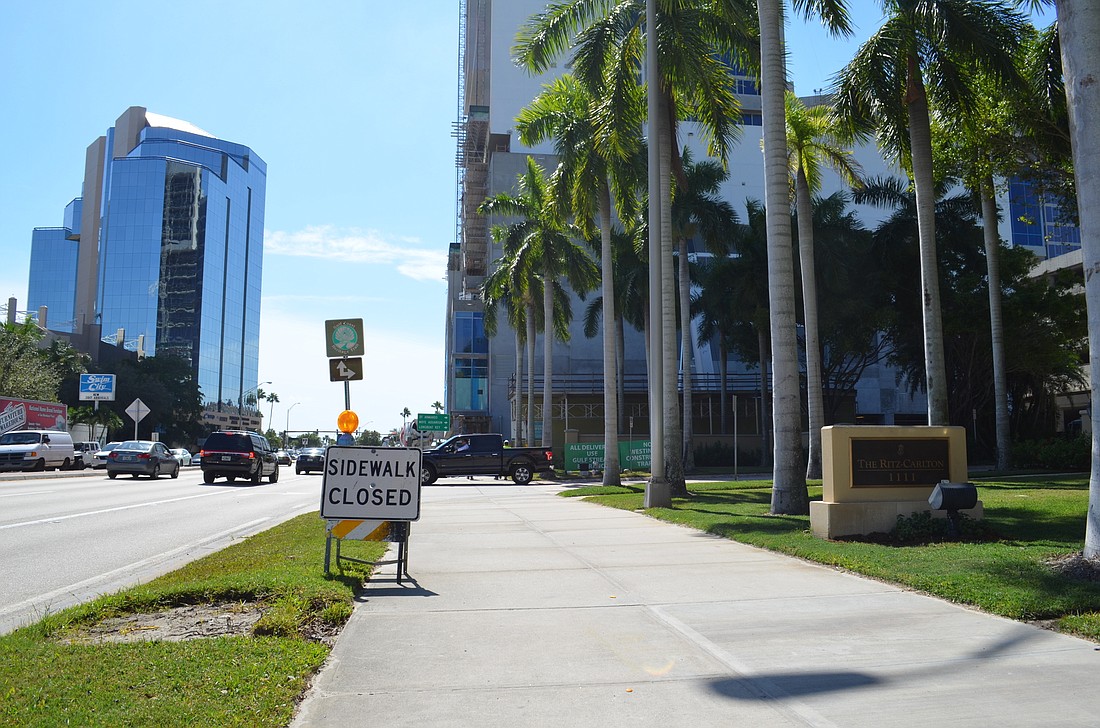- July 17, 2025
-
-
Loading

Loading

City staff has a response for the resident activist group pushing for an increased emphasis on wider sidewalks in Sarasota.
“We agree,” City Engineer Alex DavisShaw said. “We want to have good, wide sidewalks in the pedestrian corridors.”
In September, the group STOP held its first public meeting, focused on issues related to the Vue Sarasota Bay development at U.S. 41 and Gulfstream Avenue. That group is pushing for a series of city policy changes, including a mandate for wide sidewalks and tree-lined streets.
If the city is on board with the wider sidewalks, though, why the need to press the issue?
“I’m not exactly 100% sure,” said DavisShaw. “I think part of the problem right now is that the Vue is under construction.”
Although the condo-and-hotel project has been the subject of significant criticism, DavisShaw said the impacted streets will have a wider pedestrian right of way than it may currently appear.
Plans with the city call for an 8-foot-wide sidewalk along U.S. 41, with an additional landscaping area next to the roadway. Along Gulfstream, the sidewalks will be 12 feet wide. Both represent an increased width from what was there previously.
“They still are going to have a nice, wide sidewalk,” DavisShaw said.
Mike Lasche, a bicycle and pedestrian activist, is taking the lead on the sidewalk-widening issue for STOP. He’s skeptical of the city’s commitment to the cause, arguing that recent developments — including the Vue — have failed to produce meaningfully wider sidewalks.
The group is asking the city to adopt new standards outlined in “Designing Walkable Urban Thoroughfares,” a 2010 paper authored by the Congress for the New Urbanism and Institute of Transportation Engineers. It recommends at least 16 feet of pedestrian right of way along streets in the urban core, divided between sidewalks, “furnishing zones” for trees and benches, and “frontage zones” for storefronts.
The city’s engineering design criteria manual calls for, at minimum, 5-foot-wide sidewalks. That minimum increases to 8 feet for “sidewalks on high-intensity pedestrian traffic corridors.”
“What we’re saying is — you say you’re pedestrian friendly; you say you want a new urbanist policy,” Lasche said. “Go to that, and let’s use that as our standard.”
Lasche is critical of the city’s 2020 downtown master plan. He’s also skeptical about the work of the Urban Design Studio, which is producing a new form-based zoning code for the city. But both embrace the same new urbanist principles he supports.
Andres Duany, the author of the 2020 plan, is a founder of the Congress for the New Urbanism. The downtown plan created an even higher standard for rights of way on “primary” and “secondary” streets, which are designed to get heavier pedestrian activity.
As she prepares new zoning standards for the entire city, Urban Design Studio Director Karin Murphy stated emphatically new urbanist principles are informing the form-based code.
“This is designed on the context-sensitive design handbook,” Murphy said. “My friends wrote that.”
One example: Murphy wants a more organized public right of way. Lasche highlighted sidewalks with utility poles in the center of the pedestrian walkway. The new zoning code works to ensure trees and bus stops don’t interfere with people walking.
In the code, Murphy wants to expand the primary and secondary street classification outside of the downtown core. She’s also creating a new tertiary designation for streets in areas struggling to redevelop — less strict than the primary street standards, but designed to encourage gradual improvements for pedestrians.
Murphy’s proposals still fall short of the width mandate for which Lasche is asking. Murphy and DavisShaw said the city can’t just force a developer to give up part of his or her property for public use.
“Take 15 feet from a downtown property and multiple that by 10 stories,” Murphy said. “If you do that, you’ve taken an acre of someone’s property.”
The city is constrained by the amount of right of way dedicated to the road. It’s easy to get wide sidewalks on two-lane roads such as Main Street or Palm Avenue; it’s harder on four-lane roads with medians and turn lanes.
This came into play with the Vue, situated next to a major state-owned thoroughfare. It’s also shaped Fruitville Road, where the streets are lined with 4-foot-wide sidewalks.
Lasche said other cities, such as Orlando, have found a way to make developers give up some of their land for the public benefit. Murphy says that’s possible — as long as the city is willing to give up something in return. If the city is reluctant to offer density bonuses or other incentives to builders, its options are limited.
In the code, Murphy advocates for narrower travel lane widths where possible, and recommends moving away from landscaped medians, using that space for pedestrian and cyclists instead.
Traditionally, new urbanists recommend shallow building setbacks, something for which the Vue has been criticized. In the form-based code, Murphy wants to be more flexible, allowing for deeper setbacks where possible.
Although that’s associated with a more suburban setting, Murphy said it reflects the feedback she’s heard.
“We always want to get that good street frontage, but I’m not as rigid in obtaining it,” Murphy said. “Our folks want more trees, more green space opportunities. You can have both.”
As she works with staff to finalize a draft version of the code for public review, Murphy invites additional public input. She just wants to make one thing clear: She likes wider sidewalks, too.
“We’re always going to promote multimodal, walkable, bike-friendly improved quality of life in the public realm,” Murphy said.